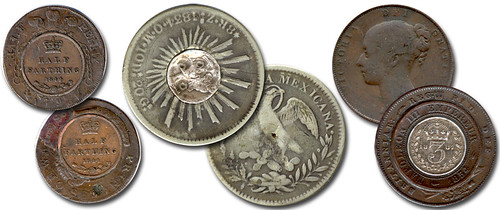
PREV ARTICLE
NEXT ARTICLE
FULL ISSUE
PREV FULL ISSUE
SOME MULTIPLE-DENOMINATION CURIOSITIES
Frank Van Valen published an interesting article on the Stack's Bowers blog on Friday, June 24, 2016. It's about some unusual
double or triple denomination exonumia items. -Editor

The beauty of exonumia is that it knows no boundaries – if it has to do with numismatics in some remote way, that’s generally good enough for an exonumia collector. My personal collection contains paper, wood, metal, plastic, and Bakelite items and more, and some of them have been featured right here at this website in my many blogs. Among my favorite exonumia items are my double-denomination pieces, but not the mint errors you might think I’m referring to. What I collect is coins that have other coins embedded or inserted into their surface, but it’s easier to illustrate than to explain. For instance, in my Conder token collection I have a curious piece. It’s a 1795 Princess of Wales halfpenny from Middlesex, D&H-977. It’s a common piece but not this example. Ever so slightly below center on the token a hole was fashioned and two 1844-dated half farthings were inserted back to back with the reverse side out. Heads or tails, there’s an 1844 half farthing present. I’m still trying to figure out what the new denomination is! Another favorite is a Mexican First Republic 8 reales dated 1834 from the Zacatecas Mint that received its parasitic partner sometime in the 20th century. I know this because the piggybacking coin is a beaten up Mercury dime placed at the obverse center of the host coin with the rays there now surrounding the dime. I just assume it’s a 1916-D Mercury dime, so all is good! The coins of Queen Victoria of England have always fascinated me, so it was only natural that I would own the final coin in this blog. At first glance it’s a well-worn English penny dated 1858 and barely above Good-4, the sort of coin you might find in a dealer’s box of three-for-a-dollar world coins. Once this worn-out old copper is flipped, however, the fun begins. Embedded in the penny is a French copper five centimes dated 1854, and embedded in the French piece is an English silver threepence dated 1887, the Jubilee Year of Queen Victoria’s reign. This piece was very carefully crafted and probably made to celebrate Her Majesty’s 50 years on the throne. To read the complete article, see:
Wayne Homren, Editor The Numismatic Bibliomania Society is a non-profit organization promoting numismatic literature. See our web site at coinbooks.org. To submit items for publication in The E-Sylum, write to the Editor at this address: whomren@gmail.com To subscribe go to: https://my.binhost.com/lists/listinfo/esylum All Rights Reserved. NBS Home Page Contact the NBS webmaster 
|